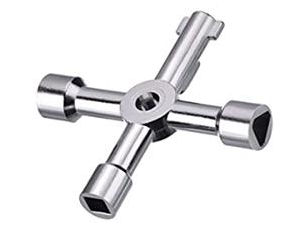Mains water is supplied to the tanks throughout the sites. You can use water from these tanks to water your plot with a watering can. Pressure hoses may be used, but you have to pay an additional water charge to the council for this and obtain your own water key. This key from Amazon is suitable for most of the tanks. It is not obligatory to pay this additional charge if you do not intend to connect a hose.
Currently the water company do not classify allotments as gardens, so we may be exempt from any hosepipe ban (but not always), but it is our policy to make sure that water is not wasted. If you apply for a shed or greenhouse, you will be required to add guttering and a water butt in line with our policy of water conservation.
The hose licence does not allow for stationary sprinklers or any use of the hose other than when held in the hand. Syphoning water from tanks to fill your own water butts is permissible, but should not be used to directly water your crops.
There is no water pressure for hoses from November to March inclusive. Water supply to the toilet is kept on as long as possible in winter, but may be turned off in cold weather. Rain water usually enables the toilet to be used all year round.
Water is available all year round at the Tea Hut (B15) standpipe but it may freeze up in a prolonged spell of exceptionally cold weather. A key is required to operate the small brass lockshield valve on the standpipe in summer.
The small type lockshield valves fitted at the Tea Hut standpipe and at the tanks at A3 and C39A require a smaller key than the older valves fitted everywhere else, and are non-repairable. When closing these valves only use enough force to stop the water flow; excessive force damages the internals which cannot be replaced. The lockshield (anti-vandal) feature is a requirement of the Town Council and the cylindrical brass shroud around the square end of operating spindle should not be removed under any circumstances as water pressure can then blow out the seal and cause a leak. The key illustrated above has both sizes of key so should therefore be suitable for all the tanks.
We need to discriminate between “minor” water leaks and “emergencies”. All leaks need to be reported. Minor leaks, dripping taps etc. however do not call for immediate action but will get fixed in due course. Emergencies, almost always caused by broken ball valves resulting in water leaking under pressure and pouring out of the hole in the side of the tank have to be attended to urgently. The recommended actions shown in the handbook are OK, but in practice could be difficult. The easiest solution is to place a stick (or a fork or a spade) across the tank and tie up the arm of the ball valve with a piece of string.
Not all tanks can be separately isolated. Two tanks on SSN at N36 and N44 have no isolating valves. Any problem requiring turning off the supply to these tanks means that the whole of the SSN site is without water.




